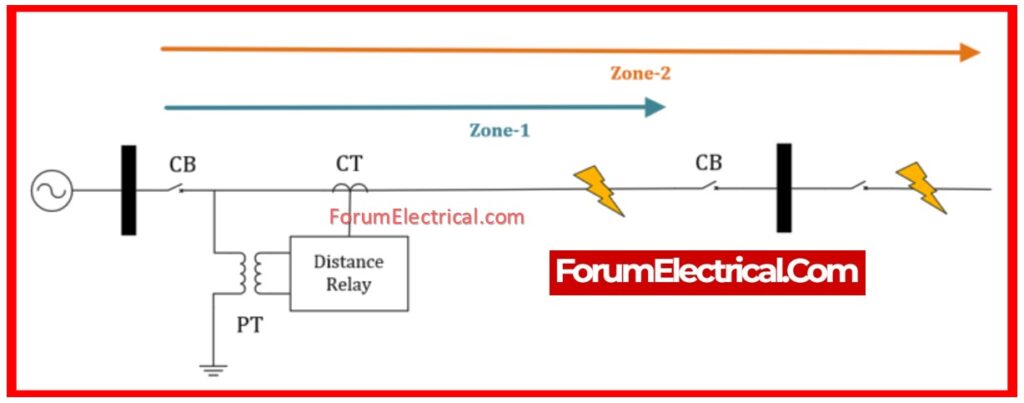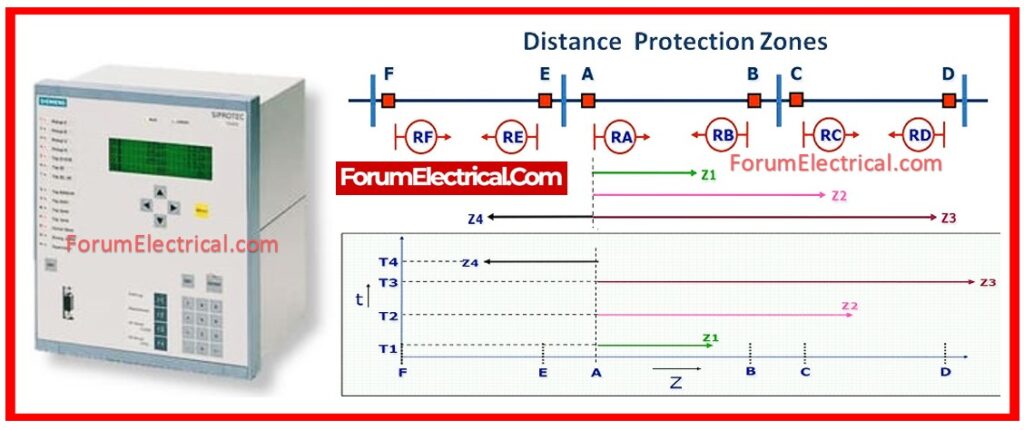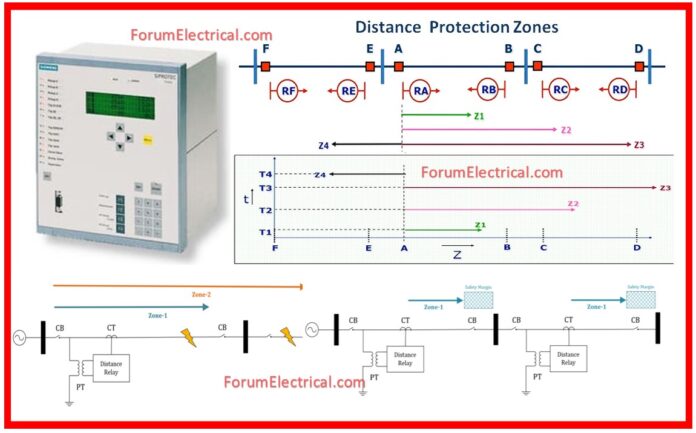Distance relays are the most essential distance protection elements, and their effectiveness is determined by the distance between the source/feeder point & the location of the fault.
- What is a Distance Relay?
- Distance Relay Working Principle
- Function of Distance Relay
- Normal Condition
- Fault Condition
- Types of Distance Relays
- 1). Impedance Relay
- 2). Reactance Relay
- 3). Admittance (Or) MHO Relay
- 4). Definite Distance Relay
- 5). Time Distance Relay
- Advantages of Distance Relay
- Disadvantages of Distance Relay
- What is the Standard for Distance Relay?
It appears that the efficiency of these relays varies based on the ratio of voltage to current is what differentiates them from other methods of protection.
These are referred to as double actuator relays since one coil is energized by the voltage while the other is energized by current.
This type of relay is most commonly employed in applications requiring fault protection, backup protection in high-speed transmission and distribution lines, and slow overcurrent relaying.
This post provides detailed information on distance relays and their various types.
What is a Distance Relay?
Distance relays are sometimes known as impedance relays, distance protection elements, or voltage-controlled devices.
The distance between the impedances of the locations wherever the fault occurs &as well as where the relay is positioned (feeding point) primarily determines its functionality.
When the voltage-current ratio is set to a predefined value or below, the relay is activated.

This relay is used to protect transmission & distribution lines during backup, fault, phase, and main operations.
The distance relay is a feature of the distance protection system that has the capability of measuring the defective point.
This relay’s mode of operation is determined by the impedance value. The condition in which the impedance of the fault point is lower than the
- Relay’s Impedance,
- Circuit Breaker Trips and
- Contacts Close.
The relay continually monitors the voltage and current passing through the PT and CT, and it begins to operate only when the voltage-current ratio (impedance value) is less than the relay’s predetermined impedance value.
Distance Relay Working Principle
The working principle of distance relay is appropriately simple and is based on the voltage-current ratio, also known as impedance.
This relay includes a potential transformer to supply voltage and a current transformer for the current element, that is connected in series with the entire circuit.
The secondary current of the CT generates deflecting torque, while the potential transformer generates restoring torque.
As we know, its operation is determined by the voltage-current ratio, or the impedance value ratio, and it is additionally recognized as an impedance relay.

The distance relay only operates when the voltage & current ratio are less than the relay’s predetermined impedance value.
Because the impedance of the transmission line is exactly proportional to its length, the relay activates if a fault occurs within length of transmission line (or) a predetermined distance.
Function of Distance Relay
The operation of a distance relay is outlined in 2 conditions:
- Normal Condition and
- Fault Condition.
Normal Condition
An operating state occurs when the line voltage (or) restoring torque exceeds the current or deflecting torque.
The impedance (or) distance relay is positioned on transmission line across the positions.
Consider the line’s impedance when it is operating. When the impedance of the line is lower than the impedance of the relay, only then does the distance relay start to function.

Fault Condition
When magnitude of current exceeds the voltage (less), there is a probability that a fault will occur on the transmission line.
This implies the current on line is inversely proportional to relay’s impedance.
As a result, the relay begins to work in this circumstance since the impedance on line reduces and falls below the pre-determined impedance value.
If a fault occurs on line, the impedance of the line is reduced below the relay’s predetermined value, and the relay starts operation by sending a tripping command to circuit breaker.
If the fault extends beyond the positive condition, the relay contacts will remain open.
Types of Distance Relays
Distance relays are grouped into 5 categories based on the voltage-to-current ratio:
- Impedance Relay
- Reactance Relay
- Admittance (Or) Mho Relay
- Definite Distance Relays
- Time Distance Relay
1). Impedance Relay
This type of relay relies on the impedance Z and is suited for the phase fault protection of a transmission line of moderate length.
2). Reactance Relay
This type of relay uses reactance X to safeguard the line against ground faults.
3). Admittance (Or) MHO Relay
The admittance Y value is what determines the type of relay that is used. This particular type of relay is suitable for the protection of long transmission lines against phase faults, severe power surges, & distance measurements.
If a fault occurs, the distance relay begins to work based on the values of impedance, admittance, or reactance.
4). Definite Distance Relay
This type of relay starts to work when the reactance or admittance value falls below the relay’s predetermined impedance value.
5). Time Distance Relay
The impedance value determines how this type of relay works. That means its operation is dependent on the distance between fault & the relay point. It works more efficiently & quickly when the fault is closer to the relay point.
Advantages of Distance Relay
- Replacing the protective function of overcurrent relays in the vicinity of transmission lines.
- Fast protection provision
- Very easy to coordinate and apply.
- Equipped with permanent settings which do not require readjusting.
- Less fault current magnitude.
- Permission for high-load linings.
Disadvantages of Distance Relay
- It is non-directional, indicating that can work from both sides of the fault.
- It is unable to discriminate between external and inside problems.
- Has a limited ability to measure fault resistance.
What is the Standard for Distance Relay?
A distance relay (ANSI/IEEE 21) is designed to trip it’s circuit breaker if a fault occurs within its specified “reach” while ignoring both normal operating loads and faults located outside of its reach.









